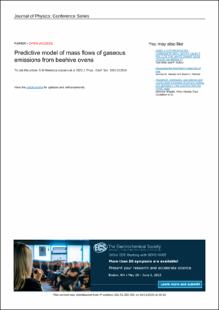Mostrar el registro sencillo del ítem
Predictive model of mass flows of gaseous emissions from beehive ovens
| dc.contributor.author | mendoza lizcano, sonia maritza | |
| dc.contributor.author | palacios alvarado, wlamyr | |
| dc.contributor.author | Medina Delgado, Byron | |
| dc.date.accessioned | 2022-11-19T20:47:59Z | |
| dc.date.available | 2022-11-19T20:47:59Z | |
| dc.date.issued | 2021-08-09 | |
| dc.identifier.uri | https://repositorio.ufps.edu.co/handle/ufps/6561 | |
| dc.description.abstract | One of the techniques used in the industry for the control of variables is, from their magnitudes, such as fuel flow, air volume, amount of material mass, among others. The ceramic industry needs to measure and control the polluting gases of its fixed sources in a less costly way, based on tools that allow agility in decision making to mitigate the adverse effects, not only to comply with a legal standard, but also for environmental and management commitment. The objective of the research is to design a predictive model of the concentration of polluting gases in the beehive ovens based on the results of the balance of matter and energy in the beehive ovens. An exploratory descriptive methodology was used, where data on beehive ovens and fourteen (14) continuous quantitative variables were considered through the statistical technique of multiple regression to analyze the predictive behavior of the pollutant concentration variables. As a result, the predictive capacity of the resulting model was high, explaining 79% of the total variation of the variable. The multiple correlation coefficient of the complete model was 0.79. During the analysis of the model assumptions, the Durbin Watson score reached a value of 1.971, evidencing compliance with the assumption of independence of the errors. | eng |
| dc.format.extent | 07 páginas | spa |
| dc.format.mimetype | application/pdf | spa |
| dc.language.iso | eng | spa |
| dc.publisher | Journal of Physics: Conference Series | spa |
| dc.relation.ispartof | Journal of Physics: Conference Series. Vol.1981 N°.1. (2021) | |
| dc.rights | Content from this work may be used under the terms of theCreative Commons Attribution 3.0 licence | eng |
| dc.rights.uri | https://creativecommons.org/licenses/by/4.0/ | spa |
| dc.source | https://iopscience.iop.org/article/10.1088/1742-6596/1981/1/012014/pdf | spa |
| dc.title | Predictive model of mass flows of gaseous emissions from beehive ovens | eng |
| dc.type | Artículo de revista | spa |
| dcterms.references | Davydova Belitskaya V, Skiba Y N, Bulgakov S N, Martínez A 1999 Revista Internacional de Contaminación Ambiental 15(2) 103-111 | spa |
| dcterms.references | Prato C J 2008 Planteamiento de Modelos Productivos para la Estandarización de los Procesos de Producción de las Mipymes del Sector Cerámico del Area Metropolitana de San José de Cúcuta (Colombia: Universidad Francisco de Paula Santander) | spa |
| dcterms.references | Prato Sánchez D F 2013 Modelación de la Dispersión de Material Particulado en Zona Minera del Cesar, Colombia, Usando Fluent (Colombia: Universidad EAN) | spa |
| dcterms.references | Cruz Virosa I, et al. 2006 Ingeniería Energética 37(3) 195-206 | spa |
| dcterms.references | Silva C, Alvarado S, Montaño R, Pérez P 2003 Biomatemática (13) 113-127 | spa |
| dcterms.references | Skrondal A 2000 Multivariate Behavioral Research 35(2) 137-167 | spa |
| dcterms.references | Bromenshenk J J, et al 1985 Science 227(4687) 632-634 | spa |
| dcterms.references | Weiwei Shi, et al 2021 IOP Confence Series: Earth Environment Science 632 052044:1 | spa |
| dcterms.references | Roa M, Rojas N Y 2006 Acta Nova 3(2) 383-397 | spa |
| dcterms.references | Campoamor Manzaneque A P 2020 Modelado Mediante el Método de los Elementos Discretos de Elementos Estructurales Multicapa de Mortero Fabricados con Impresión 3D (Spain: Universidad de Oviedo) | spa |
| dcterms.references | Luna Vilela J M 2019 Hornos de Cocción Cerámica: Impacto de las Nuevas Tecnologías en la Productividad de la Empresa (Perú: Universidad Privada del Norte) | spa |
| dcterms.references | Olsen Y, et al 2020 Atmospheric Pollution Research 11(2) 234-251 | spa |
| dc.contributor.corporatename | Journal of Physics: Conference Series | spa |
| dc.identifier.doi | https://doi.org/10.1088/1742-6596/1981/1/012014 | |
| dc.publisher.place | Reino Unido | spa |
| dc.relation.citationedition | Vol.1981 N°.1. (2021) | spa |
| dc.relation.citationendpage | 7 | spa |
| dc.relation.citationissue | 1(2021) | spa |
| dc.relation.citationstartpage | 1 | spa |
| dc.relation.citationvolume | 1981 | spa |
| dc.relation.cites | Mendoza–Lizcano, S. M., Palacios–Alvarado, W., & Medina–Delgado, B. (2021, July). Predictive model of mass flows of gaseous emissions from beehive ovens. In Journal of Physics: Conference Series (Vol. 1981, No. 1, p. 012014). IOP Publishing. | |
| dc.relation.ispartofjournal | Journal of Physics: Conference Series | spa |
| dc.rights.accessrights | info:eu-repo/semantics/openAccess | spa |
| dc.subject.proposal | Ceramics industry | eng |
| dc.subject.proposal | Decision making | eng |
| dc.subject.proposal | Environmental regulations | eng |
| dc.subject.proposal | Ovens | eng |
| dc.subject.proposal | Measure and controls | eng |
| dc.subject.proposal | Multiple correlation coefficients | eng |
| dc.subject.proposal | Multiple regressions | eng |
| dc.subject.proposal | Pollutant concentration | eng |
| dc.subject.proposal | Predictive behaviors | eng |
| dc.subject.proposal | Predictive modeling | eng |
| dc.subject.proposal | Quantitative variables | eng |
| dc.subject.proposal | Statistical techniques | eng |
| dc.subject.proposal | Predictive analytics | eng |
| dc.type.coar | http://purl.org/coar/resource_type/c_2df8fbb1 | spa |
| dc.type.content | Text | spa |
| dc.type.driver | info:eu-repo/semantics/article | spa |
| dc.type.redcol | http://purl.org/redcol/resource_type/ART | spa |
| oaire.accessrights | http://purl.org/coar/access_right/c_abf2 | spa |
| oaire.version | http://purl.org/coar/version/c_970fb48d4fbd8a85 | spa |
| dc.type.version | info:eu-repo/semantics/publishedVersion | spa |











